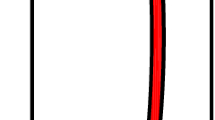Abstract
We use tighter majorizing sequences than in earlier studies to provide a semilocal convergence analysis for the secant method. Our sufficient convergence conditions are also weaker. Numerical examples are provided where earlier conditions do not hold but for which the new conditions are satisfied.
Similar content being viewed by others
References
I. K. Argyros: A unifying local-semilocal convergence analysis and applications for two-point Newton-like methods in Banach space. J. Math. Anal. Appl. 298 (2004), 374–397.
I. K. Argyros: Convergence and Applications of Newton-Type Iterations. Springer, New York, 2008.
I. K. Argyros: New sufficient convergence conditions for the secant method. Czech. Math. J. 55 (2005), 175–187.
I. K. Argyros: On the Newton-Kantorovich hypothesis for solving equations. J. Comput. Appl. Math. 169 (2004), 315–332.
I. K. Argyros, Y. J. Cho, S. Hilout: Numerical Methods for Equations and Its Applications. CRC Press, Boca Raton, 2012.
I. K. Argyros, S. Hilout: Computational Methods in Nonlinear Analysis. Efficient Algorithms, Fixed Point Theory and Applications. World Scientific, Hackensack, 2013.
I. K. Argyros, S. Hilout: Convergence conditions for secant-type methods. Czech. Math. J. 60 (2010), 253–272.
I. K. Argyros, S. Hilout: Semilocal convergence conditions for the Secant method using recurrent functions. Rev. Anal. Numér. Théor. Approx. 40 (2011), 107–119.
I. K. Argyros, S. Hilout: Weaker conditions for the convergence of Newton’s method. J. Complexity 28 (2012), 364–387.
W. E. Bosarge Jr., P. L. Falb: A multipoint method of third order. J. Optimization Theory Appl. 4 (1969), 155–166.
J. E. Dennis Jr.: Toward a Unified Convergence Theory for Newton-Like Methods. Nonlinear Functional Analysis and Applications, Proc. Adv. Sem. Math. Res. Center, Univ. Wisconsin 1970 (L.B. Rall, ed.). Publication No. 26 of the Mathematics Research Center the University of Wisconsin, Academic Press, New York, 1971, pp. 425–472.
M. A. Hernández, M. J. Rubio, J.A. Ezquerro: Secant-like methods for solving nonlinear integral equations of the Hammerstein type. J. Comput. Appl. Math. 115 (2000), 245–254.
M. A. Hernández, M. J. Rubio, J.A. Ezquerro: Solving a special case of conservative problems by secant-like methods. Appl. Math. Comput. 169 (2005), 926–942.
L. V. Kantorovich, G. P. Akilov: Functional Analysis. Pergamon Press. Transl. from the Russian by Howard L. Silcock. 2nd ed, Oxford, 1982.
P. Laasonen: Ein überquadratisch konvergenter iterativer Algorithmus. Ann. Acad. Sci. Fenn., Ser. A I 450 (1969), 10. (In German.)
J. M. Ortega, W. C. Rheinboldt: Iterative Solution of Nonlinear Equations in Several Variables. Computer Science and Applied Mathematics, Academic Press, New York, 1970.
F.-A. Potra: On the convergence of a class of Newton-like methods. iIterative Solution of Nonlinear Systems of Equations, Proc. Meeting, Oberwolfach 1982. Lecture Notes in Mathematics 953, Springer, Berlin, 1982, pp. 125–137.
F.-A. Potra: Sharp error bounds for a class of Newton-like methods. Libertas Math. 5 (1985), 71–84.
F.-A. Potra, V. Pták: Nondiscrete Induction and Iterative Processes. Research Notes in Mathematics 103, Pitman Advanced Publishing Program, Boston, 1984.
F.-A. Potra, V. Pták: Sharp error bounds for Newton’s process. Numer. Math. 34 (1980), 63–72.
P. D. Proinov: New general convergence theory for iterative processes and its applications to Newton-Kantorovich type theorems. J. Complexity 26 (2010), 3–42.
J. W. Schmidt: Untere Fehlerschranken für Regula-Falsi-Verfahren. Period. Math. Hung. 9 (1978), 241–247. (In German.)
M. A. Wolfe: Extended iterative methods for the solution of operator equations. Numer. Math. 31 (1978), 153–174.
T. Yamamoto: A convergence theorem for Newton-like methods in Banach spaces. Numer. Math. 51 (1987), 545–557.
Author information
Authors and Affiliations
Corresponding author
Rights and permissions
About this article
Cite this article
Argyros, I.K., Hilout, S. Weaker convergence conditions for the secant method. Appl Math 59, 265–284 (2014). https://doi.org/10.1007/s10492-014-0054-6
Received:
Published:
Issue Date:
DOI: https://doi.org/10.1007/s10492-014-0054-6
Keywords
- semilocal convergence
- secant method
- Banach space
- majorizing sequence
- Hölder condition
- divided difference
- Fréchet-derivative




